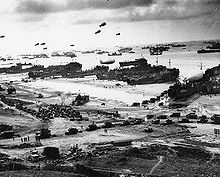Barrier balloon

A barrier balloon is a medium-sized tethered balloon that is filled with a lifting gas lighter than air and is used for warfare. The ropes are intended to prevent enemy aircraft from attacking because contact threatens to crash.
Mode of action and use

Barrier balloons should make it difficult or impossible for enemy pilots to approach ground targets , as the attacking aircraft could be brought down by the ropes of the balloons. Barrier balloons forced the pilot to fly at a higher altitude, which in the case of bombers or attack aircraft had a negative impact on their accuracy or completely prevented a promising firing position from being taken.
Low-flying combat aircraft in the target area evaded the defensive fire of anti-aircraft guns (flak), so that the deflection upwards was also useful for the defenders here. An additional military strength of the balloons was their invisibility at night. The maximum height of barrier balloons was 6,000 meters. On overcast days this was usually well above the cloud layer; the attackers flying under the clouds could not see the balloons.
Relatively thin ropes (made of steel) can hardly be seen with the eye from a fast airplane in time to be able to evade successfully. Even if such a rope is only tensioned with a relatively low force, it will twist an aircraft around its vertical axis if it - on one side - gets caught on a rope. The balloon is pulled accelerated to the kink of the rope and causes the rope tension to increase due to the increasing air resistance. The rope slides lengthways over the aircraft skin, saws itself and can also get caught in crevices or on attachments.
Barrier balloons were last used in World War II , mainly to protect industrial plants or ships from air attacks. During the Second World War, the German Empire, Great Britain, the Soviet Union and the USA used blocking balloons in large quantities. The British also experimented with “balloon aprons”, which involved tying several balloons together with ropes. The idea was dropped mainly because in the event of a defective balloon, all of the associated crashes and often damaged power lines. There were also measures to protect aircraft from blocking balloons. For example, the Luftwaffe equipped the Heinkel He 111 and Junkers Ju 88 series with balloon deflectors at the front, which, when touched, should deflect the tether outwards and, if possible, also cut it. However, this had an unfavorable effect on the flight characteristics of the bombers and also reduced the payload that could be carried.
The Royal Air Force already had completed one year before the war plans, with the help of London in the former airship factory in Cardington hedge manufactured barrage balloons from enemy aircraft:
“You could put 600 balloons at 100 yards apart across London, within ten miles of Charing Cross . [...] We will probably need around 50,000 people for this. "
For the first ten blocking balloon squadrons, the British tried to recruit 5,000 "older" men (from 38 years of age) or men who were unable to fight for health reasons. The training took place in the evenings and on Sundays all day over a period of 15 days.
In 1938 France used blocking balloons as part of the Spanish Civil War on the northern ridge of the Pyrenees at an altitude of 4,800 m, but for reasons of cost did not use this technology to protect Paris against the Germans. In addition, they did not consider them effective because the attacking aircraft increasingly had technology on board to cut the ropes of the balloons. The British Air Force, on the other hand, looked back at the end of the Second World War and assessed the importance of balloon barriers as life-saving for the city of London during the German lightning attacks in 1940–1941.
Barrier balloons were also attached to ship hulls, so 1942-1944 on the Amphitrite (after removal of the masts) in Plymouth Sound .
Modern combat aircraft are equipped with much more precise navigation systems and target devices and can therefore attack from a great height. Above all, however, the introduction of air-to-surface missiles has meant that the target no longer has to be flown over directly. Therefore, barrier balloons no longer have any practical significance these days.
See also
literature
- Wilhelm Kirchner (Colonel of the Reich Air Force ): Field balloon and air barriers. Structure, deployment and perspective of the Feldluftschiffer troop , Verlag Mittler, Berlin 1939
Web links
Individual evidence
- ^ The Times : The Aerial Stockade , Jan. 1, 1938, p. 13
- ^ The Times : The Balloon Barrage. Ten Squadrons for London. Recruiting opened. May 11, 1938, p. 13
- ↑ In order to protect Paris, according to an estimate by the Ministry of Defense on October 6, 1938, a staff of 40,000 men would have been necessary to look after the 3,000 balloons required. The cost of this was estimated at 2 billion francs. Source: Times, October 7, 1938
- ↑ See Times of September 13, 1944; P. 5
